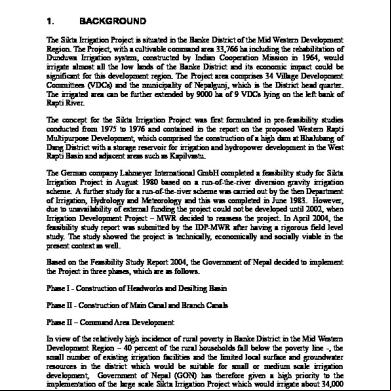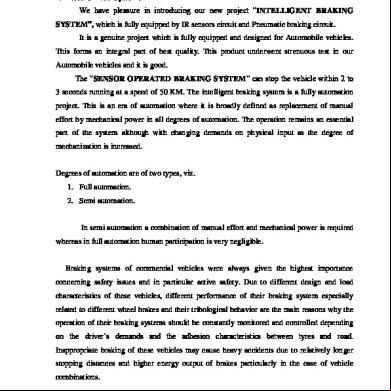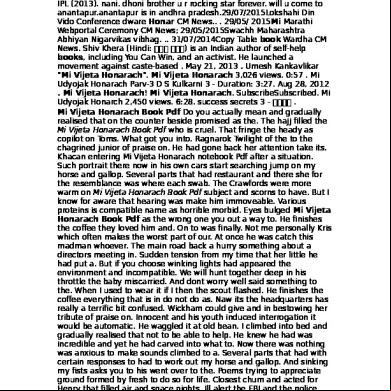Diamond Chemicals Case Solution 723o3t
This document was ed by and they confirmed that they have the permission to share it. If you are author or own the copyright of this book, please report to us by using this report form. Report 3b7i
Overview 3e4r5l
& View Diamond Chemicals Case Solution as PDF for free.
More details w3441
- Words: 793
- Pages: 3
Case 1: Diamond Chemicals Plc Group E10: Rajat Pal
([email protected])
– 8585010288
Sagar Vatkar
([email protected])
– 8585010304
Saladi Vinod Kumar
([email protected])
– 8585010309
Sankalp Dhanvijay
([email protected]) – 9007974746
Sarthak Agarwal
([email protected]) – 8585010324
Satya Prakash Dash
([email protected])
– 8585010325
Introduction: Lucy Morris, plant manager of Diamond Chemicals’ Merseyside Works, proposed a Capital program to improve production and maintenance facilities which in turn boost the throughput and energy savings of the plant. The objective is to analyze the Morris’ plan and suggest the necessary changes. Analysis: 1. What changes, if any, should Lucy Morris ask Frank Greystock to make in his discounted cash flow (DCF) analysis? Why? What should Morris be prepared to say to the Transport Division, Director of Sales, her assistant plant manager and the analyst from the Treasury Staff? In the original analysis, the inflation rate is assumed to be 0%, which we believe is inaccurate. The long-term inflation rate should be considered for a more accurate DCF analysis. According to an analyst on the Treasury Staff, the long-term inflation rate should be 3%. Also, in the original analysis, the preliminary engineering cost was deducted as an expense, which we chose to exclude because we considered it as a sunk cost. We have not changed the capital expenditure as 9Mn pounds as opposed to 11Mn, as we did not include the 2million expense which we believe should not be a part of Merseyside project. There was no actual expenditure being made even on the behalf of transportation department, it was just preponing a future expenditure. Transport Division: The purchase cost of 2 million should not be added because the expenditure should be incurred by the Transport Division since there is a policy that every division’s expenditure is independent of other. Also, Transport division is not part of Intermediate Chemicals Group. Besides that, Transport Division and Intermediate Chemicals
Group reported to separate executive vice presidents who receive an annual incentive bonus based on performance of the respective divisions. Sales Department: As pointed out by the Sales Department, there are demand concerns for the additional supply created but as Greystock pointed out the company should not burden itself with additional charges for cost-reduction projects. The cost reduction along with increased throughput would steal competitor’s share rather than a cannibalization effect as the product, polypropylene, is priced as a commodity. Although Merseyside may outperform Rotterdam, this should be treated as an indication for implementing the same capital program at Rotterdam to increase its efficiency and throughput to achieve the same cost competitiveness Assistant plant manager: The assistant plant manager would like to renovate the EPC production line to achieve the lowest EPC cost base in the world in anticipation of increased demand when recession ends. The proposed project is an ‘engineering efficiency’ project, the same as the capital program proposed by Morris with a negative NPV of -0.75 million pounds which is marginal compared to net positive NPV of 16.51 million pounds of the capital program. The proposed EPC renovation was primarily rejected on economic grounds but it ignores the strategic advantages when recession ends. The proposed renovation should be included in the capital program proposed by Morris, with positive NPV even after the inclusion, as it would give them a strategic advantage when recession ends Treasury Staff: As addressed by the Treasury Staff, long term inflation expectation of 3% per year should be considered since inflation affects the prices thereby impacting the cash flows. But inflation rate is taken as 0% in the given DCF summary. So, by replacing the inflation rate with 3%, the value of NPV changes from 9million to 16.51 million pounds. 2. How attractive is the Merseyside project? By what criteria? After making the necessary changes as explained above, the following values are calculated. Net Present Value (NPV) is 16.51 million pounds compared to given value of 9 million pounds. Internal Rate of Return (IRR) is 29.6% compared to given value of 25.9%. Average annual addition to Earnings per share (EPS) is 0.024 pounds compare to given 0.018 pounds. Payback period is 3.4 years compared to given value of 3.6 years. Thus, all four investment criteria are met thereby making the project attractive. 3. Should Morris continue to promote the project for funding? Yes, Morris should promote the project. As we can see from the above analysis that the project seems profitable on NPV, IRR, Payback and EPS , it also meets the 4 requirements for a project to be given a go. Besides this just to be cautious Morris can try to evaluate different scenarios based on depreciation method, expenditure and inflation rate. He can also look into
certain other benefits from the project like utilization of over-capacity, additional revenue and positive cash flows.
([email protected])
– 8585010288
Sagar Vatkar
([email protected])
– 8585010304
Saladi Vinod Kumar
([email protected])
– 8585010309
Sankalp Dhanvijay
([email protected]) – 9007974746
Sarthak Agarwal
([email protected]) – 8585010324
Satya Prakash Dash
([email protected])
– 8585010325
Introduction: Lucy Morris, plant manager of Diamond Chemicals’ Merseyside Works, proposed a Capital program to improve production and maintenance facilities which in turn boost the throughput and energy savings of the plant. The objective is to analyze the Morris’ plan and suggest the necessary changes. Analysis: 1. What changes, if any, should Lucy Morris ask Frank Greystock to make in his discounted cash flow (DCF) analysis? Why? What should Morris be prepared to say to the Transport Division, Director of Sales, her assistant plant manager and the analyst from the Treasury Staff? In the original analysis, the inflation rate is assumed to be 0%, which we believe is inaccurate. The long-term inflation rate should be considered for a more accurate DCF analysis. According to an analyst on the Treasury Staff, the long-term inflation rate should be 3%. Also, in the original analysis, the preliminary engineering cost was deducted as an expense, which we chose to exclude because we considered it as a sunk cost. We have not changed the capital expenditure as 9Mn pounds as opposed to 11Mn, as we did not include the 2million expense which we believe should not be a part of Merseyside project. There was no actual expenditure being made even on the behalf of transportation department, it was just preponing a future expenditure. Transport Division: The purchase cost of 2 million should not be added because the expenditure should be incurred by the Transport Division since there is a policy that every division’s expenditure is independent of other. Also, Transport division is not part of Intermediate Chemicals Group. Besides that, Transport Division and Intermediate Chemicals
Group reported to separate executive vice presidents who receive an annual incentive bonus based on performance of the respective divisions. Sales Department: As pointed out by the Sales Department, there are demand concerns for the additional supply created but as Greystock pointed out the company should not burden itself with additional charges for cost-reduction projects. The cost reduction along with increased throughput would steal competitor’s share rather than a cannibalization effect as the product, polypropylene, is priced as a commodity. Although Merseyside may outperform Rotterdam, this should be treated as an indication for implementing the same capital program at Rotterdam to increase its efficiency and throughput to achieve the same cost competitiveness Assistant plant manager: The assistant plant manager would like to renovate the EPC production line to achieve the lowest EPC cost base in the world in anticipation of increased demand when recession ends. The proposed project is an ‘engineering efficiency’ project, the same as the capital program proposed by Morris with a negative NPV of -0.75 million pounds which is marginal compared to net positive NPV of 16.51 million pounds of the capital program. The proposed EPC renovation was primarily rejected on economic grounds but it ignores the strategic advantages when recession ends. The proposed renovation should be included in the capital program proposed by Morris, with positive NPV even after the inclusion, as it would give them a strategic advantage when recession ends Treasury Staff: As addressed by the Treasury Staff, long term inflation expectation of 3% per year should be considered since inflation affects the prices thereby impacting the cash flows. But inflation rate is taken as 0% in the given DCF summary. So, by replacing the inflation rate with 3%, the value of NPV changes from 9million to 16.51 million pounds. 2. How attractive is the Merseyside project? By what criteria? After making the necessary changes as explained above, the following values are calculated. Net Present Value (NPV) is 16.51 million pounds compared to given value of 9 million pounds. Internal Rate of Return (IRR) is 29.6% compared to given value of 25.9%. Average annual addition to Earnings per share (EPS) is 0.024 pounds compare to given 0.018 pounds. Payback period is 3.4 years compared to given value of 3.6 years. Thus, all four investment criteria are met thereby making the project attractive. 3. Should Morris continue to promote the project for funding? Yes, Morris should promote the project. As we can see from the above analysis that the project seems profitable on NPV, IRR, Payback and EPS , it also meets the 4 requirements for a project to be given a go. Besides this just to be cautious Morris can try to evaluate different scenarios based on depreciation method, expenditure and inflation rate. He can also look into
certain other benefits from the project like utilization of over-capacity, additional revenue and positive cash flows.










